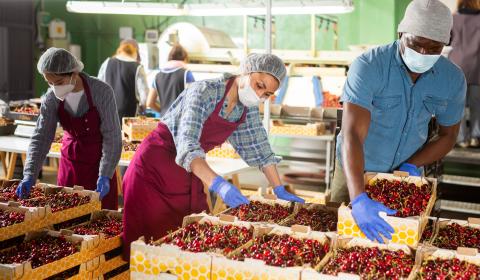
Biosafety certification: ensuring the safety of workers in the food supply chain
In October 2021, the US congress released a report investigating COVID-related health conditions across several major American meatpacking plants in Iowa over a year-long period. The report found that insufficient health procedures and policies—and a lack of proper health and safety management—had led to devastating viral outbreaks. This resulted in the infection of more than 56,000 employees in the first year of the pandemic.[1]
A month after the report, health ministers of the G7 nations noted that COVID-19’s latest variant, Omicron, is now “the biggest current threat to global public health.”[2] While many businesses have adopted remote work policies, most employees in the food supply industry don’t have that option. This puts them at greater risk of exposure to the virus and raises the question: what can organizations in the food industry do to protect their workforce?
Easing food industry worker worries
A general fear of illness is contributing to an industry-wide labor shortage in many areas of the world. With job seekers reluctant to take up potentially hazardous roles,[3] employers are facing difficulties both hiring and retaining frontline workers. A continued labor shortage could have serious ramifications: exacerbated production disruption, product and service shortages, and even company closures.
To reassure all stakeholders that a workplace is operating safely and to minimize potential negative outcomes, an organization must develop effective biosafety policies—and put those into practice.
Risk mitigation through preparation
Lack of preparedness can exacerbate the effects of an infectious disease outbreak. Establishing a company-wide management system to proactively manage risk, and implementing preventative measures is essential.
Here are some major steps that should be included:
- Conduct a thorough risk assessment
- Identify and provide sanitary resources such as disinfectants and no-touch bins
- Provide appropriate personal protective equipment (PPE)
- Establish communication responsibilities and channels to disseminate key information
- Control workplace hazards by installing physical barriers or adapting working hours to reduce the risk of physical contact
- Determine potential skills gaps in the event of absence and avoid by cross-training employees
Developing an integrated infectious disease management system not only enables organizations to better protect employees. It supports them to deliver uninterrupted service to stakeholders in the event of a crisis.
Putting occupational health at the top of the agenda
Bureau Veritas’ biosafety certification offer promotes a management systems approach to preventing workplace contamination. It requires organizations to create and execute preventative measures, best practice controls, and industry-compliant sanitary protocols. It also requires an action plan focusing on key issues such as absenteeism, activity interruptions, compliance obligations and employee cross-training.
Certification from Bureau Veritas bolsters your reputation by demonstrating your commitment to continuous improvement and the highest health and safety standards.
Want to find out more about our biosafety certification offer? Learn more
[1]https://www.iowapublicradio.org/health/2021-12-15/plants-politics-dig-s
[2]https://www.france24.com/en/health/20211217-g7-calls-omicron-biggest-threat-to-global-health-biden-warns-of-spread-in-us
[3]https://www.researchgate.net/publication/345336133_Labor_Issues_in_the_Food_Supply_Chain_Amid_the_COVID-19_Pandemic